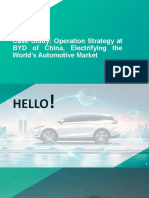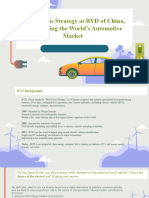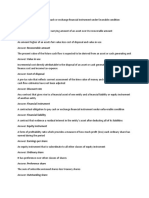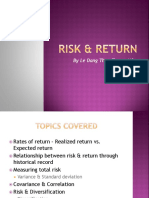Proceedings of the 2023 International Conference on Management Research and Economic Development
DOI: 10.54254/2754-1169/26/20230564
Analysis on BYD Current Development and Future
Direction
Lingui Huang1, a, *
1
School of Slavonic and East European Studies, University College London, London, WC1H 0BW,
UK
a. yjmsuab@ucl.ac.uk
*corresponding author
Abstract. The issue of vehicle emissions is one of the primary contributors to greenhouse
gases and, by extension, global warming. One of the current solutions to the emissions
problems caused by vehicles is the use of new energy vehicles to supplant fuel vehicles. This
paper concentrates on a SWOT analysis of BYD using secondary data to understand BYD's
current external and internal situation and to investigate what factors may be impeding BYD's
advancement in the new energy vehicle market. The paper concludes that BYD's reliance on
policy subsidies as well as its bad after-sales service and supporting facilities may account
for the company's slow continued growth. By establishing a solid after-sales system and
expanding its global market, BYD will be able to address the aforementioned issues.
Consequently, by analysing BYD as a leading player in China's new energy vehicle market,
the results of this paper can be beneficial for the Chinese new energy vehicle market and can
also serve as a reference for other new energy vehicle companies confronting comparable
issues. It can assist investors in comprehending the current state of BYD.
Keywords: new energy vehicle, BYD, government subsidies, SWOT
1. Introduction
Under the strategy of global sustainable development, individuals began to recognise the significance
of reducing carbon emissions. Transportation contributed 37% of global carbon emissions, and more
than 90% of total vehicle emissions can be attributed to particulate emissions from traditional fuel
vehicles [1]. The use of new energy vehicles as opposed to fuel-powered vehicles can reduce total
vehicle emissions, which can significantly alleviate the current carbon emissions problem. Therefore,
the rapid development of the new energy vehicle industry has attracted significant investor and
government support and funding. BYD is a high-tech company committed to "meeting the aspirations
of people for a better life through technological innovation" [2].
After more than 20 years of rapid growth since its establishment in February 1995, BYD has
constructed more than 30 industrial plants worldwide, contributing significantly to the development
of its industrial chain and the exploration of international markets [3]. BYD focuses on technological
innovation and employs more than 20,000 R&D personnel worldwide, fostering independent
innovation and international development. BYD's innovations include a number of industry-leading
technologies and patents, the majority of which are world leaders. The new energy vehicle industries
are essential to BYD's development in the future [2]. However, there is still a substantial disparity
between the market share of new energy vehicles and fuel vehicles [4]. This indicates that BYD
requires additional development to increase the market share of new energy vehicles. Numerous
© 2023 The Authors. This is an open access article distributed under the terms of the Creative Commons Attribution License 4.0
(https://creativecommons.org/licenses/by/4.0/).
152
� Proceedings of the 2023 International Conference on Management Research and Economic Development
DOI: 10.54254/2754-1169/26/20230564
researchers conduct SWOT analyses of BYD or other new energy vehicle companies, and the author
observes that people will mention the assistance of Chinese policy for new energy vehicles; however,
the dependence on policy subsidies must be taken into account. Additionally, the author will elaborate
on this subject.
This paper analyses BYD's current market position and uses SWOT analysis to investigate what
has delayed BYD's development and how it can promote BYD's future growth. The analysis assists
the public in comprehending the current state of new energy vehicles in China, including what
strengths new energy vehicle companies should possess, what deficiencies may hinder their
development, and what opportunities and threats they face. This paper's analysis will assist investors
in BYD in gaining a better understanding of the current situation and will contribute to the provision
of constructive advice on the development of the new energy vehicle sector. It can also provide
beneficial solutions for businesses in the new energy vehicle industry that are experiencing similar
issues.
2. SWOT Analysis
2.1. Strength
2.1.1. Technology Status and the Full Supply Chain
BYD is the only manufacturer of electric vehicles with a complete three-electric industry chain.
(electric power, electric motor, and electric control). This assures its advantage in providing superior
technology integration and competitive pricing, making it difficult for any automaker in the world to
catch up. BYD's electric control system is a self-developed SiC MOSFET, and its motor is a
permanent magnet synchronous motor that is smaller and lighter than other motors with the same
power and torque, allowing for more battery capacity. The BYD battery is the only blade battery in
the world to pass the nail penetration test, indicating that it cannot catch fire [5]. It is a highly
professional barrier due to the heat resistance, high pressure resistance, crystallisation resistance, and
high density of its ultrathin heat sink.
2.1.2. The Wide Product Portfolio
BYD's extensive product portfolio, which includes electric vehicles, batteries, solar panels, energy
storage systems, 'Total Solutions' for eMobility, and monorails, enables the company to diversify its
revenue streams and reduce its reliance on a single product or market.
Figure 1: The product of BYD (Souce: https://www.bydglobal.com/en/index.html).
The extensive product lineup of BYD gives the company a competitive advantage over its rivals.
It enables BYD to offer a variety of solutions to its customers and to satisfy their diverse needs, which
can help the company attract more customers and expand its market share. BYD's business structure
incorporates the disciplines of electronics, automotive, new energy, and rail transportation, and it
plays a significant role in these industries from energy acquisition, storage, and application to build
a comprehensive, zero-emissions new energy solution [3]. In the case of BYD cloud rail, the cost of
construction is only one-fifth that of underground; the cost of construction time is only one-third that
of underground; and the electricity consumption of cloud rail is approximately 0.57 degrees/km per
100 people, making it the best mode of public transportation for cities with low population density,
153
� Proceedings of the 2023 International Conference on Management Research and Economic Development
DOI: 10.54254/2754-1169/26/20230564
urban and rural areas, and major tourist attractions [6]. The initiative has also received bids from
numerous nations and regions. Multiple nations and regions have submitted winning bids for the
undertaking.
2.2. Weakness
2.2.1. Poor Ancillary Facilities and After-Sales Management
After-sales service plays a crucial role in moulding consumers' perceptions of a car brand and can
have a substantial impact on their purchase decision [7]. According to the data, China's consumer
associations received 649 complaints, 279 of which concerned BYD's after-sales service [8].
Undoubtedly, BYD has the most after-sales service complaints on the Chinese auto market [8-9]. It
can demonstrate that BYD's after-sales service is a severe issue that could impact the company's
reputation and sales volume [10].
After-sales service is a potent safeguard for the rights and interests of consumers. The fundamental
objective of after-sales service is to protect the rights and interests of consumers. After-sales service
is not standardized, and the unbalanced development of product quality and product technology will
become a limiting factor in BYD's ability to actively compete with well-known foreign automakers.
In addition, a paucity of charging stations for new energy vehicles and higher prices will be
emphasized, making consumers less likely to purchase BYD products [11]. The fundamental
charging facilities for BYD's new energy vehicles are also primarily concentrated in cities of the first
and second tiers, whereas there are even fewer charging piles in other cities. As BYD's R&D and
production base for new energy vehicles, Xi'an is unable to address the charging problem of new
energy vehicles.
2.2.2. Over-Dependence on Policy Support
According to Figure 2 of BYD's annual report, one of its disadvantages is its excessive reliance on
the Chinese market. Not only is it detrimental to BYD's development on the international market, but
it is also susceptible to domestic economic and policy influences [2]. BYD depends significantly on
government support. BYD's 2021 Annual Report indicates it received CNY 2.3 billion in government
subsidies in 2021, which accounted for approximately 57% of its net income that year [2]. Other
forms of government support that benefit BYD include local government purchases of businesses. As
the industry leader, BYD has financial assistance income of RMB2,263 million, RMB1,678 million,
and RMB1,678 million included in current profit and loss for 2019-2021, accounting for 91.94
percent, 39.63 percent, and 74.3 percent of the year's net profit, respectively.
70
60.13
60
50
39.67
40
30 21.19 22.63
20 17.08 16.88
10
0
2019 2020 2021
Net Profit Government grants and subsidies
Figure 2: The data of government grants and subsidies and net profit on BYD from 2019-2021 [2]
[12-13].
154
� Proceedings of the 2023 International Conference on Management Research and Economic Development
DOI: 10.54254/2754-1169/26/20230564
2.3. Opportunity
2.3.1. Policy Subsidies
In China, policy support for new energy vehicles has been progressively elevated to the level of a
national strategy, and government agencies at all levels have provided substantial support for the
development of new energy vehicles. The Chinese government has implemented a series of vehicle
consumption stimulative policies, including a 50% reduction in purchase tax, monetary subsidies, and
consumption vouchers, to stimulate market dynamics and promote vehicle consumption. With policy
support, BYD can reduce production costs and increase technological research and development,
thereby expanding its market share and enhancing its corporate reputation. National policy, social
philosophy, and market outlook all point to a tremendous opportunity for BYD to accomplish
industrial upgrading as the leader of the domestic automobile industry.
2.3.2. Global Market
BYD finds Europe and Southeast Asia to be an attractive market. Although Europe is the second
largest market for new energy vehicles in the world, with new energy vehicles accounting for 27.2%
of the global market, the penetration rate is only 18.1%, with pure electric vehicles accounting for
12.1% of the car market, leaving ample room for growth [14]. All European nations have enacted
legislation to support the development of new energy vehicles, making Europe the region with the
shortest energy transition worldwide. Europe is also the most economically developed region in the
world, with the greatest per capita wealth, so expanding its presence in Europe will aid in enhancing
its reputation.
Southeast Asian nations support the development of new energy vehicles through their legislation,
and the trend towards electrification is quite evident. In addition, Southeast Asia is a significant source
of upstream raw materials, and the expansion of new energy businesses in the region would enable
BYD's entire industrial chain to maximise its advantages more effectively. Therefore, BYD must take
advantage of the global market's development opportunities in order to introduce its new energy
vehicles to the global market.
2.4. Threat
2.4.1. Policy Uncertainty
Government subsidies are a significant factor in the advancement of novel energy vehicles. The three
primary sources of financial support for BYD are research and development subsidies, industrial
support funds, and promotional subsidies. In recent years, however, national subsidies for new energy
vehicles have been progressively reduced or eliminated, creating a more challenging market
environment for new energy vehicle manufacturers. The subsidy rate for new energy vehicles will be
reduced by 30% from 2021 to 2022; the subsidy rate for urban buses and other vehicles that meet
policy requirements will be reduced by 20% from 2021 to 2022 [15]. The subsidy policy for the
procurement of new energy vehicles for 2022 will expire on December 31, 2022 [15].
BYD's 2022 current ratio is calculated to be 0.72, which is very low compared to the 2022 current
ratio of 1.02 for the same industry [16-17]. BYD's corporate solvency and liquidity are weak, its long-
term capital structure is extremely asset-heavy, and its short-term liquidity is insufficient to quickly
realise liquid assets, further decrease as a result of government subsidy cuts.
As the government reduces subsidies, BYD's net profit will decrease [2, 12-13]. The reduction in
subsidies will have an impact on BYD's innovation efficiency, R&D capacity, and marketing
capacity. BYD's share of the domestic market will be impacted if policy subsidies for new energy
vehicles continue to decline in the future. This will impact the company's ultimate profitability.
155
� Proceedings of the 2023 International Conference on Management Research and Economic Development
DOI: 10.54254/2754-1169/26/20230564
2.4.2. Domestic Technology Threat
China's industry chain for new energy vehicles is relatively comprehensive, and the barrier to entry
for new energy vehicles is low. Thus, a number of prominent internet companies, including Huawei,
Xiaomi, DJI, Baidu, etc., have announced their entrance into the new energy vehicle industry. It is
anticipated that their entry will alter the playing field and elevate the technical level of new energy
vehicles, particularly in autonomous driving.
The power battery is the fundamental technology of new energy vehicles, and the current
automotive power battery unicorn is Ningde Time. Ningde Time has a market share of over 30 percent
and has gained orders from Tesla, Azera, Peng, and other major manufacturers of new energy
vehicles. The ternary lithium battery from Ningde Time has a high range capacity and is the preferred
battery for automobiles. In terms of cost control, Ningde Times has a comprehensive industrial layout,
with equity cooperation with third parties throughout the entire industry chain, and industry-leading
profit margins; BYD primarily adopts the approach of self-production + equity participation, and
there is still a gap between the two in terms of the number of equity enterprises and shareholding
ratio. Under these conditions, if BYD does not continue to develop its battery technology, Ningde
will take over the battery market share, resulting in a decline in BYD's overall profitability.
3. Recommendation
For the sake of global sustainability, new energy vehicles will eventually supplant fuel energy as the
primary mode of transportation [18]. BYD should address its weaknesses and surmount its threats in
order to expand its market share and consolidate its global leadership position.
First, BYD's inadequate after-sale management is a significant problem. In the process of the rapid
development of the new energy vehicle industry, service is the most essential product component [7].
Consequently, a comprehensive and refined after-sales service system is a deficiency that should be
promptly addressed by automotive companies. BYD should establish a perfect after-sales service
system, expand regional openness, improve management standardization, improve service
convenience, solve problems for consumers from a practical standpoint, and thereby increase
consumer satisfaction, thereby increasing customer loyalty to new energy vehicles and laying the
groundwork for the future occupation of the new energy market.
Government grants and subsidies are a double-edged sword for corporations producing new energy
vehicles. From the development of their products to the construction of urban infrastructure to the
marketing of their products, the development of China's new energy vehicle companies is aided by
policy subsidies at every stage, from the construction of urban infrastructure to the marketing of their
products. These stages are never undertaken without the financial support of the local government.
This has caused many companies to rely excessively on government subsidies, reducing their
autonomy and industrial excellence. As mentioned in the opportunities section, government grants
can significantly assist BYD in reducing production costs and expanding its market presence.
However, an excessive reliance on government grants and subsidies will diminish BYD's
independence, thereby decreasing its risk tolerance. Under these conditions, BYD's net profit and
production line will be susceptible to domestic policy shifts. Therefore, BYD should be aware of the
company's degree of reliance on government grants and subsidies, as well as how this will impact the
business. BYD could reduce its reliance on government subsidies by exploring the international
market.
By increasing its global market share, BYD can operate its business with greater resilience and
less reliance on government intervention. BYD is able to identify demand based on the new energy
market in various countries and swiftly enter the market to capitalise on it. In the same way that you
cannot place all of your eggs in one container, globalisation can reduce the impact of individual
regions on the company's growth, thereby reducing dependence on policies and simultaneously
increasing profitability.
156
� Proceedings of the 2023 International Conference on Management Research and Economic Development
DOI: 10.54254/2754-1169/26/20230564
4. Conclusion
The paper conducts a SWOT analysis to evaluate BYD's external and internal environment, and then
makes recommendations for the company's future strategy and objectives. According to an analysis
of BYD's weaknesses and threats, inadequate ancillary facilities and after-sales management, as well
as government overdependence, are the most significant obstacles to BYD's market expansion and
global development. Nevertheless, based on an analysis of opportunities and strengths, BYD's
technological status, comprehensive supply chain, extensive product portfolio, policy support, and
global market serve as the firm foundation for its position as the global leader in the new vehicle
market. BYD should address the issue of after-sales service by establishing a flawless service system
and enhancing management standardisation for market expansion. BYD must be aware of the
implications of its reliance on government subsidies for the company. Despite the difficulties, a
business that grows with assistance cannot outperform a business that grows independently.
Due to the fact that the paper performed a SWOT analysis on the available information, this work
identifies and discusses BYD's issues with a degree of brevity. It is nearly impossible to analyse all
of BYD's problems using this internal and external analysis alone. In conjunction with SWOT
analysis, it is necessary to employ additional analysis techniques, such as PEST analysis, to gain a
more complete comprehension of BYD's current issues and future development trends.
The acquisition of data consists primarily of secondary data and web data, and primary data will
unquestionably improve the effectiveness of the data in the paper. In the future, it will be possible to
obtain more accurate and useful data through the employing of interviews.
References
[1] Teter, J. Transport – analysis. IEA. 2022. https://www.iea.org/reports/transport
[2] BYD COMPANY LIMITED 2020 ANNUAL REPORT. bydglobal. 2021. https://www.bydglobal.com/
[3] Masiero, G., Ogasavara, M. H., Jussani, A. C., & Risso, M. L. Electric vehicles in China: BYD strategies and
government subsidies [J]. RAI Revista de Administração e Inovação, 2016.13(1), 3-11.
[4] Automotive industry production and sales in 2022. China Association Automobile Manufacturers. 2022.
http://www.caam.org.cn/chn/4/cate_39/con_5236639.html
[5] BYD switches to EV batteries it says won't ever Catch fire - bnn bloomberg. BNN. 2021.
https://www.bnnbloomberg.ca/byd-switches-to-ev-batteries-it-says-won-t-ever-catch-fire-1.1587574
[6] Rail transit. BYDglobal. (n.d.). 2021. https://www.bydglobal.com/en/Rail.html
[7] Yadav, S. K., & Joseph, D. After-sales service quality satisfaction in Indian automobile industry [J]. International
Journal of Business Information Systems, 2017, 26(3), 362-377.
[8] Analysis of complaints about automotive products received by national consumer association organisations in 2018.
China Consumers Association. 2019. https://www.cca.cn/tsdh/detail/28416.html
[9] BYD, BMW and Mercedes-Benz Top China Auto Complaints, Consumers Group says. Yicai Global. 2019.
https://www.yicaiglobal.com/news/byd-bmw-and-mercedes-benz-top-china-auto-complaints-consumers-group-
says
[10] Nicod, L., Llosa, S., & Bowen, D. Customer proactive training vs customer reactive training in retail store settings:
Effects on script proficiency, customer satisfaction, and sales volume [J]. Journal of Retailing and Consumer
Services, 2020.55, 102069.
[11] Hu, Z. Research on the consumer behavior characteristics and marketing strategy of new energy vehicles——taking
BYD and Tesla as examples [J]. BCP Business & Management. 2022. 31, 168–175.
[12] BYD COMPANY LIMITED 2018 ANNUAL REPORT. bydglobal. 2019. https://www.bydglobal.com
[13] BYD COMPANY LIMITED ANNUAL REPORT 2019. bydglobal. 2020. https://www.bydglobal.com
[14] Bello, C. Sales of electric cars in the Eu broke records in 2022. Which country in Europe is leading the way?
Euronews. 2022. euronews.com/next/2023/02/20/sales-of-electric-cars-in-the-eu-broke-records-in-2022-which-
country-in-europe-is-leading.
[15] Notice on the Financial Subsidy Policy for the Promotion and Application of New Energy Vehicles in 2022. 2021.
http://jjs.mof.gov.cn/zhengcefagui/202112/t20211231_3780322.html
[16] Group 1 automotive current ratio 2010-2022: GPI. Macrotrends. (n.d.). Retrieved April 5, 2023, from
https://www.macrotrends.net/stocks/charts/GPI/group-1-automotive/current-ratio
[17] BYD COMPANY LIMITED 2022 ANNUAL REPORT. bydglobal. (2023, March 28). Retrieved April 6, 2023, from
https://www.bydglobal.com
157
� Proceedings of the 2023 International Conference on Management Research and Economic Development
DOI: 10.54254/2754-1169/26/20230564
[18] Yuan, X., Liu, X., & Zuo, J. The development of new energy vehicles for a sustainable future: Renewable and
Sustainable Energy Reviews [J]. ELSEVIER. 2015, 42, 298-305.
158
















































































